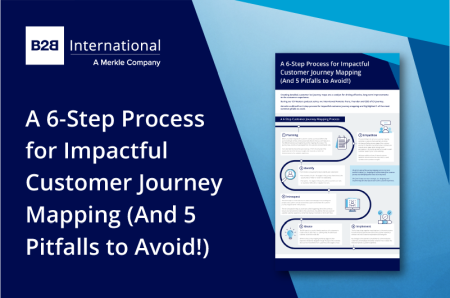
The B2B world has come a long way over the last decade, from a time when it was the exception for companies to invest deeply in customer experience, to today where the majority of major brands clearly see their success connected to the customer. Consumer brands took the lead, realizing that customers’ expectations were shifting greatly as the digitization of the purchase journey opened a need to engage customers across a far broader range of channels and make use of a growing wealth of data. Many B2B brands have accepted that customer experiences formed in the consumer world are shaping expectations for experiences in the B2B sphere. And as we’ve seen in our own research, Millennials and Gen Z are also becoming more influential in B2B purchasing, helping to shift expectations of customer experience.
While great progress has been made by brands in terms of building their CX capabilities, the need for smart investment remains as important as ever. Merkle’s most recent Consumer Experience Sentiment Report showed that consumers place excellent customer experience as their top priority for brands to focus on, particularly higher amongst those aged under 45. However, there is still a gap in the experiences that many brands believe they are delivering and what customers believe they are receiving. B2B International’s latest annual CX tracker across 500 B2B brands has shown that there is still a considerable gap across all measures critical for CX success, particularly in the way companies are living up to delivering a seamless experience or being proactive. Opportunities for growth towards CX excellence are still abundant for most B2B brands.
As the latest Merkle CX Imperatives report has shown, brands can foster greater improvements in CX by future-proofing their organizations through clearly articulated visions for customer experience. Ultimately every experience can be seen as a pathway towards a commerce experience, which requires a mindset of constant learning to identify new revenue streams and organizational structures to meet the ever-growing level of customer expectation. Ideally everything should flow from close CX alignment and smart investment, through focused use of technology, people and marketing. Insight will continue to play a pivotal role too.
So, in what ways will insight help B2B brands future-proof their organizations and ensure improvements in CX translate through to commerce opportunities? There are typically three stages we see B2B organizations go through to use insight to strengthen their CX capabilities:
-
Map the customer journey
Creating a Customer Journey Map (CJM) is an ideal framework for representing what the customer experience looks like today. It is a visual representation of customer interactions with a company and can be used as a tool to investigate, analyze and lay the foundations to improve customer experiences. They are a great resource to bring together disparate teams across an organization to provide greater understanding of how they can work better together to meet the needs of customers in the future.
The CJM is a blueprint for the journey taken by the customer, marking all touchpoints. It should extend from touchpoints designed to raise awareness and interest – including advertising and marketing efforts, PR, etc. – through to the touchpoints associated with usage e.g., sales reps, accounts teams, support services, complaints handling, etc. It should also extend to the cessation of the relationship with the company e.g., switching to an alternative provider.
Customer journey mapping, as part of a customer journey research study, provides a great starting point; placing the experience of the customer at the heart of what the company does and how it operates.
-
Deep dive into key issues
Having gained a comprehensive understanding of the customer journey, it is likely that you will have identified further issues to explore. This could include certain customer types or personas who need to be investigated further (e.g. they have been experiencing a particular challenge or have a certain need that is being unmet), or it could include an issue that affects a broader base of customers where you need a more detailed understanding (e.g. many customers are looking for more digital solutions but the current offer is limited and you need to explore what they want, or even how to commercialize this).
At this stage qualitative research can prove extremely valuable at getting underneath the surface of a particular issue. This could take the form of a series of in-depth interviews with a selection of customers to discuss their experience in a lot more detail, with specific questions designed to get to the heart of key challenges and how they relate to their overall experience. This will also provide an opportunity to begin to explore potential solutions to improve CX with customers.
-
Track ongoing performance
Once a solid baseline understanding of the customer journey and any critical issues has been established, it is best practice to assess your performance at delivering against customer expectations going forward. This can typically take the form of a CX tracker or brand health tracking study, where a quantitative assessment is made across customer types and geographies.
A survey will be developed to measure your performance (and that of competitors) against key metrics that are meaningful to customers, derived from earlier CJM and qualitative research (such as lead times, responsiveness, proactivity etc.). They survey results are then used to provide a health assessment of a brand’s CX performance and help focus attention on the areas that need to be improved in the coming months, until the survey is repeated to assess the progress that has been made. Establishing a tracking program like this is one of the best ways to future-proof a business for CX growth, committing to listening and learning from customers for the long term.
At B2B International we have been at the forefront of B2B CX research for many years and will continue to advocate the use of insight to drive meaningful CX experiences. To discuss your business needs and objectives and determine how our research can help, reach out to one of our research experts.



